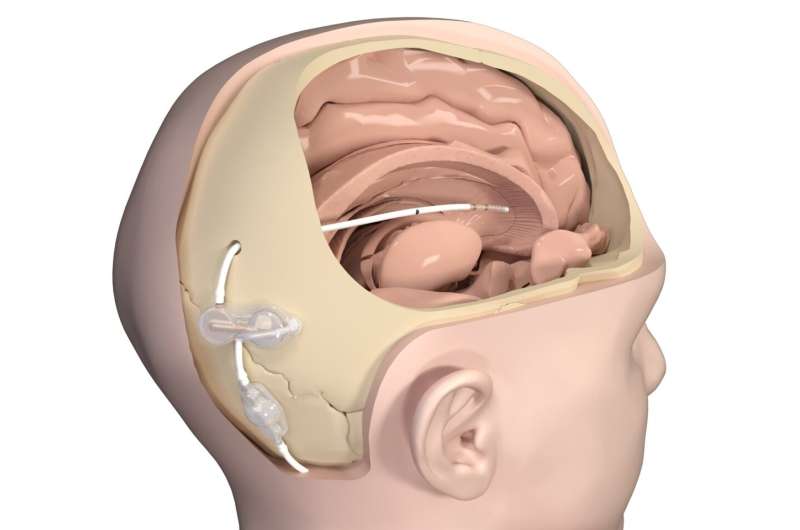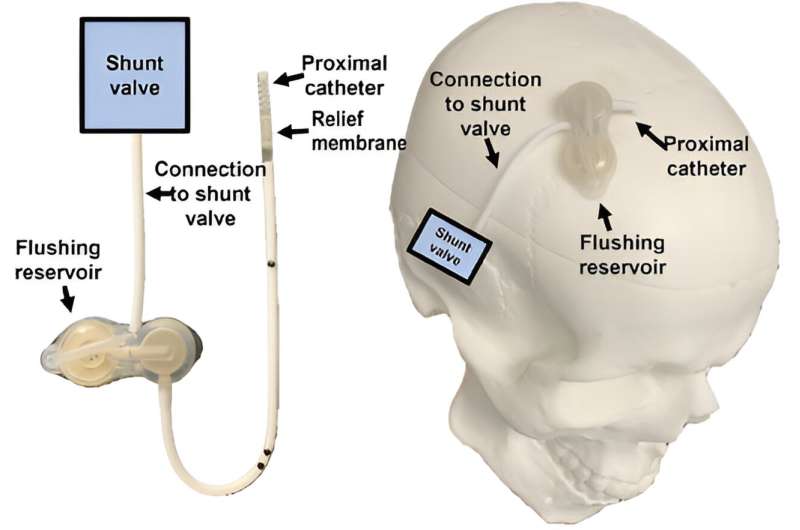This article has been reviewed according to Science X's editorial process and policies. Editors have highlighted the following attributes while ensuring the content's credibility:
fact-checked
trusted source
proofread
Flushing regimen with simple implant may prevent shunt clogs, reduce revision surgeries in hydrocephalus patients

Hydrocephalus, commonly known as fluid or water on the brain, can occur in the womb or be caused by hemorrhage, tumors, trauma or infection. The "water" in this case is an excess of cerebrospinal fluid in the brain's cavities. As fluid accumulates, pressure builds in the brain, compressing and damaging tissues. This often leads to physical and behavioral changes like headache, seizures and sluggishness, among many others, and it can be fatal.
While there is no cure for hydrocephalus, it can be managed by surgical placement of a shunt to divert the CSF out of the brain. But malfunction rates due to blockage or infection are high—up to 40% within the first year and 85% by 15 years—and children can spend much of their lives in and out of hospitals for revision surgery.
In a recently published study in Pediatric Neurosurgery, Ramin Eskandari, M.D., and his colleagues at the Medical University of South Carolina describe a case series of patients who received a shunt-clearing implant along with a preventative regimen to prevent blockage. The dramatic results of this small descriptive study show the potential for families to have some control over hydrocephalus and enjoy a higher quality of life with less interruption by malfunction and surgery.
Eskandari and his team saw the prophylactic potential of the ReFlow ventricular system, a flushing device developed by Anuncia Medical to remove blockages that can build up in shunts due to scarring, infection or other debris. While the device was marketed as a nonsurgical way to clear catheter obstructions, the MUSC team believed that regular flushing might prevent blockage in the first place.
The team began implanting the system into children who had suffered post-hemorrhagic hydrocephalus—they had already had bleeding in the brain—and were at high risk for malfunction because of past revision surgeries or infections. They also developed a protocol where a parent or family member would be trained to push the flusher button twice a day as a prophylactic measure.
Eskandari liked that the implant didn't add any harm to the patient or difficulty to the surgical procedure. "You simply implant one extra device during surgery, and this can be beneficial and potentially prevent future surgeries," he said. "And if the catheter does block, you can open it up and turn what would have been an emergency into a non-emergency case."
Nine patients received the ReFlow system and started routine daily flushing to keep the shunt clear of debris. These patients were monitored for 2.8 to 4 years, and during that time just one patient returned for revision surgery. In contrast to this one complication over the course of years, the same group of children had received a total of 14 revision surgeries in the two years prior to the study.
"In the first few years after their implant, these patients just weren't coming back, other than for follow-up," said Eskandari. "We weren't seeing any malfunctions. It was just staggering."

Interestingly, while all the others had 100% compliance, the patient requiring revision had only 50% compliance prior to malfunction. After revision, this patient's compliance increased to 100%, and the patient had no further complications.
The health care team at MUSC trained family members to perform the very simple process of pushing a small button under the skin, using lifelike models to make them comfortable and then coaching them while they performed it on their child. The flushing device uses a tiny amount of fluid—less than half a milliliter of fluid already present in the system—to clear the very small shunt diameter, so children do not feel any discomfort during their daily routine.
In their testing, the device manufacturer measured that more than 110,000 flushes can be performed before the silicone of the device begins to show wear, making it very safe for daily use.
Hydrocephalus is a stressful condition that often manifests as emergency situations and surgeries in the middle of the night. With the simple action of clearing the shunt regularly, families could take some control and ownership over an uncontrollable situation. And while they remained very aware that complications and surgeries could arise, much of the psychological weight of helplessness was lifted.
The small size of the first study does not allow for robust statistical analysis, but the results are compelling. A large, multicenter study is now being planned to offer the ReFlow device to any patients who are good candidates and to gather more data.
One drawback of the original ReFlow system was its size. It was too large to be implanted into neonates who were born with hemorrhaging or infections and was only suitable for children of two to three years and up. Anuncia Medical has since developed a smaller version that is suitable for newborns, so future studies will be able to look at the benefits of the system starting right from the point of shunt placement.
"I'm so excited to have a game-changing option for hydrocephalus," said Eskandari. "It is by far the most common condition we treat in neurosurgery, and it's also by far the most stressful because it almost always happens with zero warning."
There are even further implications for preventative care on a global scale. There are currently alternatives to shunts that can work for about half of patients with hydrocephalus, but the other half require shunts and can have even higher rates of malfunction and infection than those in the developed world. If an affordable flushing system becomes available worldwide, the life-saving impact could number in the tens of thousands.
More information: Michael Vinzani et al, Use of a Prophylactic Retrograde-Flushing Device in High-Risk Pediatric Patients with Ventriculoperitoneal Shunts: A Technical Note, Pediatric Neurosurgery (2023). DOI: 10.1159/000530869





















